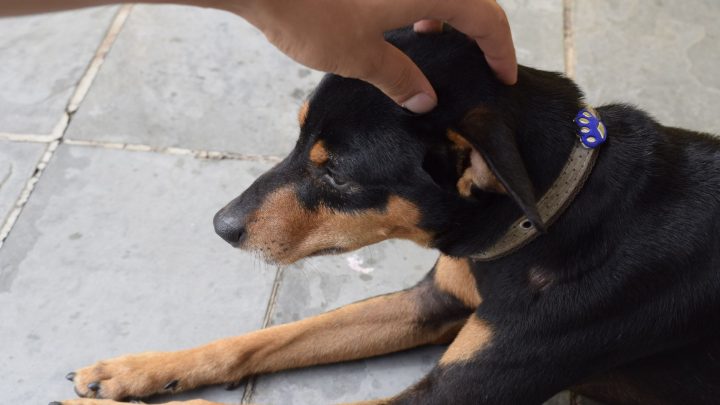Has your got a hot head? Do you want to know exactly why this is the case? Are you concerned that your dog might be ill and do not know what to do? Then come one and all, as we briefly explore today some of the key reasons you might be encountering a dog hot head, going through some of the most essential to the most drastic and least likely.

Table of Contents
Why is My Dog’s Head Hot?
There are a number of reasons this might be the case, and your eventual course of action will be based on the specific reason for the hot-headedness.
Fever
This is more of a drastic reason, but can just as easily be the case in a dog as it can in a human.
A dog’s normal body temperature will be around 101 degrees Fahrenheit (38 degrees Celsius). A human’s average body temperature is around 35 degrees Celsius.
Why Might a Dog Have a Fever?
- They might well have an infection or an inflammation somewhere, diverse agents of viruses, bacteria, and fungi plotting against the dog in question, causing its immune system to retaliate. There will typically be a series of other symptoms if it is indeed to do with infection.
- Similarly, vaccination can cause a feverish reaction, especially seeing as it is often enacted by introducing a bacterial or viral infection into the body of the creature. Thankfully, the side effects of vaccinations will only last a couple of days.
- The ingestion of substances that are toxic to dogs can cause a feverish reaction also.
If a dog’s temperature is consistently above 103 degrees Fahrenheit, then you are advised to follow a treatment plan once you have assessed the root cause.
How to Check a Dog’s Temperature
There are a number of different thermometers you can use for the job.
Rectal thermometers are exactly what you think, meaning you will have to lubricate them and put them into your dog’s butt to record the readings.
A digital thermometer will save you this disservice, allowing you to place it on the external body of the dog so that you can take an accurate reading in less than a minute.
An ear thermometer is easily the most expensive of the three. This you will place horizontally into the dog’s ear canal (if you can get them to stay still enough, of course).
How to Act
Ensure that your dog has enough water in its system, lest it dehydrates, overheats, and dies. Food is important though less essential. It would be wise to know how to get a sick dog to eat.
Applying water to the outside of the dog will also work a treat. So sprinkle cool water on the fur, head, ears, and feet to lower general body temperature.
If you follow these actions and also use prescribed suppressant drugs for the possible infection with no signs of improvement, then consult your vet as soon as possible.

The Cooling Process
Less drastically, of course, a dog might simply be cooling down as a part of its own process of doing so.
Dogs are well known for their ability to automatically transport warm blood to the head before sending it where it is most needed, in spots that are going to feel the loss of heat more acutely.
To prevent this process from malfunctioning you can ensure that the fur is brushed thoroughly and regularly. This way, the flow of air is maintained properly to all the parts of its external body.
Living in a dry environment that is free of cold winds will also be of help. A conducive temperature is maintained by the dog without having to keep engaging that natural cooling process.
Climate
Of course, your dog’s reaction would be nothing without considering the environment in which it is residing. In reaction to the heat of the sun and direct sunlight, it will be no wonder that a dog has a hot head. Indeed, the longer it spends in the sun, the higher chance it has of garnering a hot head.
A safe environment for your dog will be one that:
- is secure from any attacks, be they from wild or dangerous creatures or loud and unexpected visitors.
- is free of draughts but is regularly aerated and dry so that the dog’s natural cooling process is not experimented with.
- is spacious enough to provide adequate facilities in which a dog can play and also go to the toilet comfortably.
- has comfortable bedding and other pleasant places to lounge.
- must at least have some areas that provide a quiet space that the dog can go to so as not to be disturbed.
Stress
Equally, a dog might just be getting a little stressed. You might have overworked your dog while exercising or simply fooled around. This overexcitement can therefore manifest itself physiologically.
Equally, perhaps the dog in question has encountered a strange and/or dangerous animal. Maybe a strange event like a change of environment, thunderstorm, or fireworks. All of these things can have a detrimental effect on the nerves of a dog.
It can be relatively easy to solve these things. However, by simply taking your dog out of these situations as much as you possibly can.
Once you have assessed all of the other reasons listed here, you can be more or less sure that a dog is just a little stressed and is exhibiting it in its own way. Still, it would be best to know when to take a dog to the vet.
Dog’s Head is Hot – Last Bark
So, there you have it!
Hopefully, your nerves have been put to ease a little via this article. Your dog’s hot-headedness is purely to do with something that can be easily prevented at home. Or, perhaps you have been made aware of something that you now need to consult your veterinarian about!
FAQs
A slightly warm or cool head in dogs is usually normal and not a cause for concern. Dogs’ body temperatures can vary, and their heads might feel warmer or cooler at different times. If you’re concerned about your dog’s body temperature or overall health, it’s always best to consult your veterinarian.






